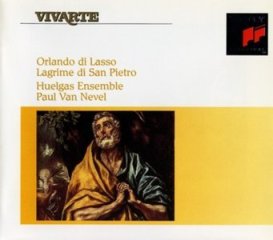Orlando Di Lasso - Lagrime Di San Pietro (1993)
Orlando Di Lasso - Lagrime Di San Pietro (1993)

1. Part I: I. Il Magnanimo Pietro 2. Part I: II. Ma Gli Archi 3. Part I: III. Tre Volte Haveva 4. Part I: IV. Qual A L'incontro 5. Part I: V. Giovane Donna 6. Part I: VI. Cosi Talhor 7. Part I: VII. Ogni Occhio Del Signor 8. Part II: VIII. Nessun Fedel Trovai 9. Part II: IX. Chi Ad Una Ad Una 10. Part II: X. Come Falda Di Neve 11. Part II: XI. E Non Fu Il Pianto Suo 12. Part II: XII. Quel Volto 13. Part II: XIII. Veduto Il Miser 14. Part II: XIV. E Vago D'incontrar 15. Part III: XV. Vattene Vita Va 16. Part III: XVI. O Vita Troppo Rea 17. Part III: XVII. A Quanti Gia Felici 18. Part III: XVIII. Non Trovava Mia Fe 19. Part III: XIX. Queste Opre E Piu 20. Part III: XX. Negando Il Mio Signor 21. Part III: XXI. Vide Homo Huelgas Ensemble: Marius van Altena - Tenor Willem Ceuleers - Bass Ibo van Ingen - Tenor Harry van der Kamp - Bass Katelijne van Laethem - Vocals Otto Rastbichler - Tenor Cecilia Roovers - Vocals Marie-Claude Vallin - Soprano Stephane Van Dijk - Tenor Paul van Nevel - Conductor
This is one of Lassus's masterpieces, written shortly before his death. A specialist in late medieval and Renaissance vocal music, Van Nevel is the ideal performer for this work and this recording is one of his best. Oddly, this 1993 disc was released at the same time as another outstanding performance, by Philippe Herreweghe's Ensemble Vocal Européen. It is hard to choose between the two recordings, which, though different in their options, are both equally compelling and rewarding. Van Nevel uses discreet instrumental accompaniments while Herreweghe's performance is strictly a capella. Herreweghe's cast has more stars, such as Maria Cristina Kiehr, Gerd Türk, and Peter Kooy, but Van Nevel's regular ensemble attains the same coherence and fervor. It is a rare luxury to have two performances of this caliber, and those who really enjoy this music will want both. --- Peter Janssens, amazon.com
Orlandus Lassus was the most famous composer of the second half of the 16th century. The publication of the ‘Lagrime di San Pietro’ is a testimony of his fame. It is a splendid edition, prepared with utmost care by Adam Berg in Munich, who had published Lassus’s works since 1567.
Lassus himself never saw the edition. It appeared in 1595, one year after his death. The last five years of his life were difficult. From 1587 onwards he suffered from melancholia and hallucinations. Shortly before his death he was able to compose again, and he decided to select twenty sacred madrigals from the collection ‘Lagrime di San Pietro’ by the Italian poet Luigi Tansillo (1510 – 1568), which contained forty-two stanzas of eight lines (‘ottave rime’) on the grief and the repentance of St Peter after his denial of Christ. To these twenty madrigals Lassus added a Latin motet.
The images used in secular poetry were often used in sacred poetry as well. The love for a lady was transferred to the relationship between the believer and Mary or Jesus. The ‘Lagrime’ is no exception. It contains elements which also appear in secular poetry of the time.
The ‘Lagrime’ doesn’t describe the events at the cross, but the feelings of St Peter about what is going on, and in particular his role in it. Lassus’s music is following the text very closely, making use of the madrigalisms which were in vogue.
There is also strong symbolism in the settings by Lassus. This symbolism turns around the numbers seven – all madrigals are set for seven voices - and three – the cycle is divided into three sections. The whole cycle contains twenty-one items; three times seven. The number seven is associated with sorrow and sin, the number three here refers to the number of times St Peter denied Christ.
There are different theories regarding the reasons why Lassus composed this work. Some believe that, since Lassus felt his end was near, he thought it necessary to do penance for his sins – for instance, his composition of secular works on morally dubious texts – and a composition like this was the best way to do so. Whether this is true or not, this work certainly had a personal meaning for Lassus, as in the dedication he called it "a personal devotion at this difficult age".--- Johan van Veen, musicweb-international.com
download: uploaded anonfiles yandex 4shared solidfiles mega filecloudio nornar
Zmieniony (Poniedziałek, 27 Styczeń 2014 15:10)








